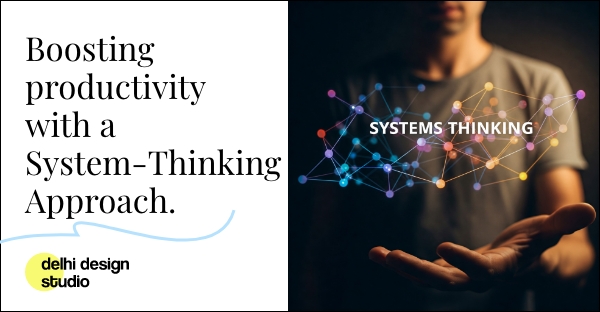
What Is Systems Thinking in UX Design?
Systems Thinking is a holistic approach that focuses on understanding how different elements within a product ecosystem are interconnected. Rather than designing individual screens in isolation, systems thinking encourages you to examine the entire experience — from front-end user flows to backend logic.
Think of it like looking at a city on Google Maps instead of just one street. You begin to see patterns, relationships, and potential problem areas you might’ve missed when you were zoomed in too close.
Step 1: Map the Experience
Start by creating visual representations — diagrams, user journey maps, and service blueprints — that outline how every component in your UX system connects. This step is crucial for identifying:
By “mapping the system,” you can streamline interactions and uncover opportunities for simplification.
Step 2: Question Every Element
Be intentional. Every element on your screen should serve a purpose.
Ask yourself:
If your answer is “we’ve always done it that way,” dig deeper. A systems thinking mindset challenges assumptions and champions design decisions that are purposeful and user-centric.
Step 3: Design Systems, Not Just Screens
Designing screens in isolation often leads to inconsistencies and disjointed experiences. Systems thinking shifts your perspective toward how each screen, action, and component fits into the overall structure.
Key Considerations:
Consistency breeds usability, and systemic thinking ensures your design ecosystem stays aligned.
Step 4: Implement Feedback Loops
Don’t design in a vacuum. Regularly test, measure, and iterate.
Feedback loops allow you to:
Pro Tip: Use tools like A/B testing, heatmaps, and usability testing to gather both qualitative and quantitative data.
Step 5: Collaborate Across Disciplines
Great systems are built through collaboration. Involve stakeholders from development, marketing, support, and even sales.
Each team brings a unique perspective that can highlight hidden dependencies or future obstacles. The more diverse your input, the more robust your system becomes.
Strategies to Simplify UX Design Using Systems Thinking
Now let’s dive into some actionable techniques that align beautifully with a systems approach:
Prioritize Core Features
Avoid feature creep. Focus on what delivers the most user value. Ask:
Embrace Minimalist UX Design
Minimalism isn’t just visual — it’s strategic. Use:
Standardize UI Elements
A consistent interface reduces user confusion. Ensure gestures, icons, and behaviors remain uniform throughout your product.
Simplify Information Architecture
Help users find what they need quickly:
A streamlined IA makes for a smoother, faster user journey.
Use Progressive Disclosure
Reveal complexity gradually. Show only what users need at each stage, and provide advanced options as they go.
Example: Offer basic settings up front, with an expandable “Advanced Settings” panel.
Automate Repetitive Tasks
Look for ways to reduce user effort:
Automation enhances flow and reduces friction.
Wrapping It All Up: Start Thinking in Systems
Simplifying UX through systems thinking isn’t about removing complexity for the sake of minimalism — it’s about managing complexity intelligently. It's about seeing the forest and the trees.
When you take a step back, ask the right questions, and design for the system — not just the screen — you create user experiences that are streamlined, scalable, and delightful to use.
So the next time your UX feels like a cluttered junk drawer, just remember: Systems thinking is your design decluttering toolkit.
#UIUXDesign #UserExperience #UXDesign #UIDesign #DesignSimplicity #MinimalistDesign #ProductDesign #DigitalDesign #UXTips #DesignInspiration #SteveJobsWisdom #HumanCenteredDesign #DesignThinking #CreativeDesignAgency #SimplicityInDesign #UXMatters#InterfaceDesign #WebDesignAgency #DesignWithPurpose #AppleInspiredDesign #LessIsMore#CleanDesign #UXAgency #UserFirstDesign #DesignLikeJobs